Culture, nature in Metro Manila’s neighbor

Daranak falls
ANTIPOLO CITY — Rizal’s tourism industry could be hurting from a major road accident that killed 15 people on a school trip in February, but thanks to its thriving culture and natural wonders and accessibility, the province sees a good chance of recovering fast.
A predominantly Tagalog-speaking province, Rizal is Metro Manila’s closest neighbor, located just 16 kilometers to the capital’s east. It is said that the national hero, Dr. Jose Rizal, as a child, used to come here with his mother Teodora Alonso Realonda, a devotee of Our Lady of Peace and Good Voyage, the province’s patroness.
Local culture and history are served raw to Rizal’s visitors.
“If you want history, sit around under a mango tree or a local sari-sari store and the old folks could tell you [anything], even with their feet up on a table,” said Dr. Corazon Laserna, Rizal provincial tourism chief.
Laserna said Rizal’s selling points were the unique character of each town. The provincial government has been training local tour guides, teaching them, for instance, basic greetings in different foreign languages.
Rizal’s annual tourist arrival reaches around 6 million, peaking during the Holy Week and summer. Majority of foreign guests are Japanese, Koreans and Chinese.
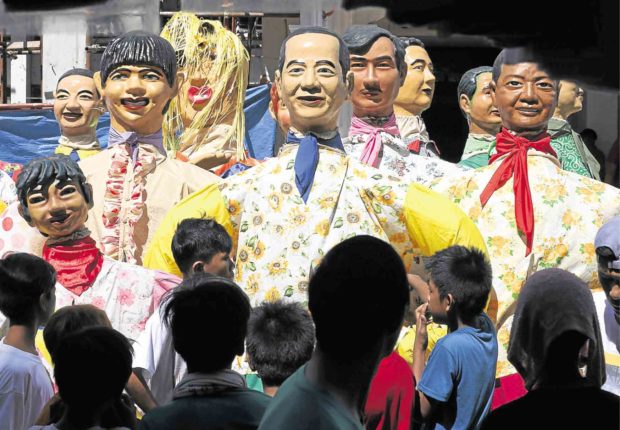
Angono town is famous for its “Higantes,” or giant papiermâché effigies. —NIÑO JESUS ORBETA
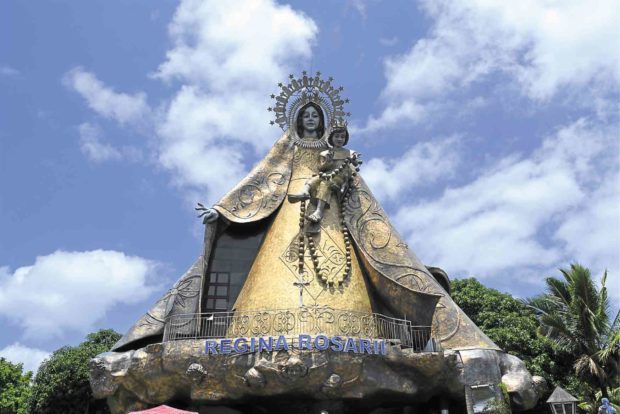
The Regina Rica, a giant statue of the Queen of the Holy Rosary in Sampaloc village, also in Tanay. TANAY TOURISM OFFICE
‘Hané?’
In Tanay town, tricycle drivers offering trips to the Calinawan cave and Daranak falls greet hikers and backpackers once they disembark at the town’s transport terminal.
With an area of 33,466 hectares of greenery, Tanay has become a favorite destination for outdoor activities. As part of the Sierra Madre mountain ranges, the province offers challenging trails up Mt. Daraitan, the Masungi rock formation and the Tinapak river and rock formation. In Rodriguez town, there are also Mt. Pamitinan and Mt. Binacayan.
“These rock formations are too ordinary for locals. They do not realize how attractive these could be for tourists,” said Medel Mendez of the Tanay municipal tourism office.
From the local expression “hané,” often used to convince another person to agree with you, Tanay derives its brand as the “Home of Adventure and Nature Experience.”
People longing for a weekend breather might want to consider a quick drive up Tanay’s Calinawan cave, some 9 km from the town center. Situated in Barangay Tandang Kutyo, the seven-layer cave (although only five layers have been explored so far) takes tourists deep down the mountain, 80 to 90 feet below sea level.
Cave guides say Filipino guerrillas held their meetings inside the cave, thus giving “kalinawan” (clarity) to their plans.
Inside, tourists walk a few hundred meters while training flashlights on rock formations. Early this year, a tourist held his wedding inside the cave, which was also used often for shooting films and television shows.
The cave tour does not require much of crawling and is dry in most parts, yet the walk is tiring just the same. A 20-minute walk, via a shortcut, or a 20-minute drive around the village, brings one to the Daranak falls to cool off.
Daranak is a 14-foot (4.23 m)-high waterfall and Tanay’s “flagship destination.” It is being managed by the local government, while the nearby Batlag falls is privately owned.
Aside from taking a dip in its freezing waters, visitors will be entertained by watching locals do rock balancing.
Sonny Judar, who practices rock balancing, said it was a learned skill to meticulously place a rock on top of another until the pile was steady.
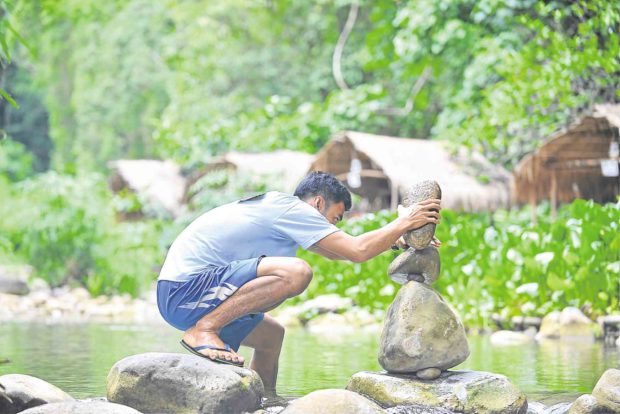
Rock balancing in Daranak falls —NIKON CELIS
Ecotourism
“Our tour packages depend on what tourists are looking for,” Laserna said. “We have ecotourism, culinary, arts, and even the very old churches,” she said.
Still in Tanay are San Ildefonso de Toledo Church, a national heritage site, and Regina Rica (Rosarii Institute for Contemplation in Asia). Located in Barangay Sampaloc, Regina Rica is a 71-foot (21.6 m)-tall statue of the Queen of the Holy Rosary inside the sanctuary of the Dominican sisters.
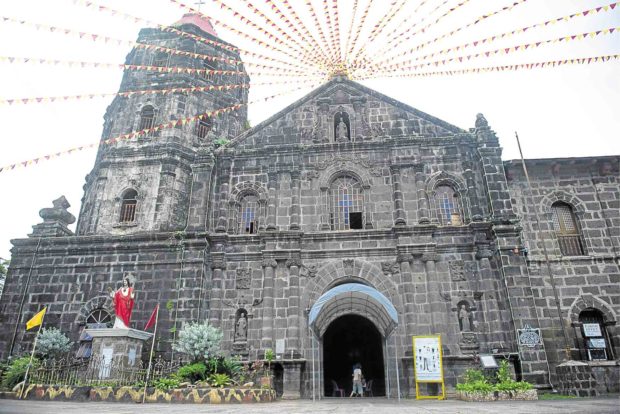
The San Ildefonso de Toledo Church in Tanay is among Rizal’s oldest Catholic churches. —NIKON CELIS
From here, a 15-minute drive takes you to the wind farm in the adjacent Pililia town. The 54-megawatt wind farm generates electricity for more than 66,000 households.
There are several hotels in Tanay but backpackers usually spend the night at Keno’s Lodge or at Sampaloc Inn.
Make sure you don’t miss Kainan sa Tabi ng Lawa, which serves a variety freshwater fish, or Rambull’s, a 24-hour restaurant along Manila East Road.
Rambull’s is a favorite stop of bikers as it serves beef dishes, including their hot bowl of soup made with bull testicles.
Nature-tripping turns into an art tour and food crawl once you head down to Antipolo City, the province’s capital and its lone city.
Antipolo is not Antipolo without a visit to the cathedral, or the Shrine of Our Lady of Peace and Good Voyage, where everything comes to life once Masses start at dawn. Seeing vendors selling assorted trinkets and toys, and families taking pictures by the giant kasuy (cashew) and suman, is an experience by itself.
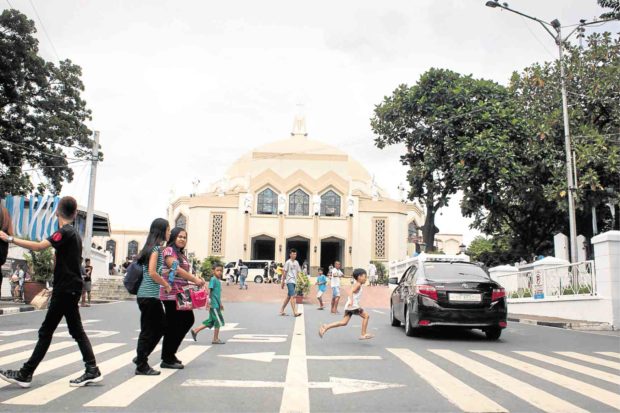
The Shrine of the Our Lady of Peace and Good Voyage, or Antipolo Cathedral, attracts pilgrims and devotees year-round. —CLIFFORD NUÑEZ
Marino Bacani, city tourism officer, said thousands flocked to the cathedral on ordinary days and millions during weekends and Holy week.
Since the 1960s, Antipolo’s pasalubong center right outside the cathedral has been known for its cashew nuts (sold for P500-P600 a kilogram) and suman sa ibos (rice cake wrapped in banana leaves, at P50 per 10 pieces). The suman comes from the nearby town of Cainta, while the cashew nuts are from Palawan province.
“But what makes them taste so good and different is the way they are cooked here, especially our adobong kasuy,” he said.
Another Antipolo landmark is Hinulugang Taktak Falls, made popular by the 1920s song, “Tayo na sa Antipolo” (Let’s go to Antipolo) of German San Jose.
History has it that in the 16th century, residents were bothered by the sound of the church bell, leaving the priest no choice but to “taktak” or get rid of it by dropping the bell into the river.
Bacani said Hinulugang Taktak drew between 2,000 and 4,000 visitors during weekends. “(Before) you wouldn’t dare go down (the falls area) because of the smell of trash,” he said.
In 2014, the provincial government ordered the falls closed for a year for rehabilitation and the relocation of 925 families of illegal settlers. The falls has been reopened, allowing visitors to swim in a manmade pool while the waterfall undergoes purification, Bacani said.

Never miss Hinulugang Taktak in Antipolo City. —CLIFFORD NUÑEZ
Art tour
Antipolo is one of Luzon’s upland cities, like Baguio City in Benguet province and Tagaytay City in Cavite province. Many establishments and cafés, like those along the ridge on Sumulong Highway, offer not only a cool breeze but a totally different view of Metro Manila.
While still in this city, visit Pinto Art Museum, a 1.2-ha gallery of modern and contemporary art. You will know you are headed the right direction when you see a 100-meter stretch of sunflower mural upon entering Grand Heights Subdivision.
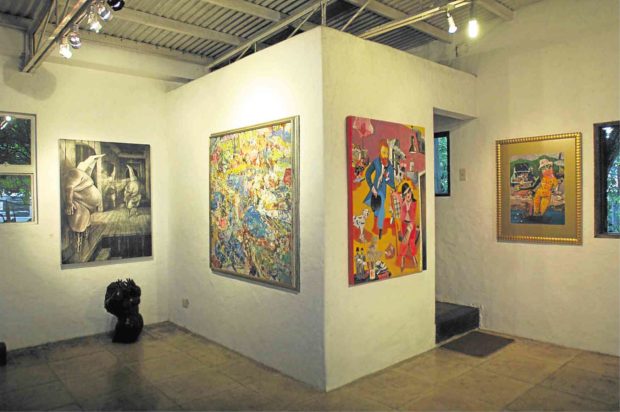
The Pinto Art Museum is a must-stop in Antipolo City. —INQUIRER PHOTO
From the Antipolo cathedral, a 15-minute drive takes you to the Angono Petroglyphs, a large rock wall where 127 animal and human-like figures are engraved.
In 1965, national artist Carlos “Botong” Francisco, a native of Angono town, discovered the engravings. Archaeologists consider the Petroglyphs the oldest Philippine artwork dating back to 3,000 B.C.
There is no public transportation from the Petroglyphs to Angono town center, except by hiring tricycles. Once in Angono, everything seems to be within walking distance as you hop from one gallery to another.
Angono is known for producing generations of sculptors, painters, musicians and poets, said tourism officer Bernard Laca Jr. Among the popular galleries is the Blanco Family Museum, which keeps a collection of works by renowned painter Jose “Pitok” Blanco and his family members.
Just a few blocks away is the Doña Aurora street, a 300-meter lane popularly known as the mural street. Replicas of Francisco’s works are sculpted on bas-reliefs by homegrown artists, among them Charlie Anorico, Gerry Batangas and Alex Villaluz, adorning the façades of houses.
“The local government is really working to preserve the art culture — for instance, by providing art lessons to students,” Laca said. He said they were also promoting the works of budding artists to ensure that the “influence” was passed on to the next generations.
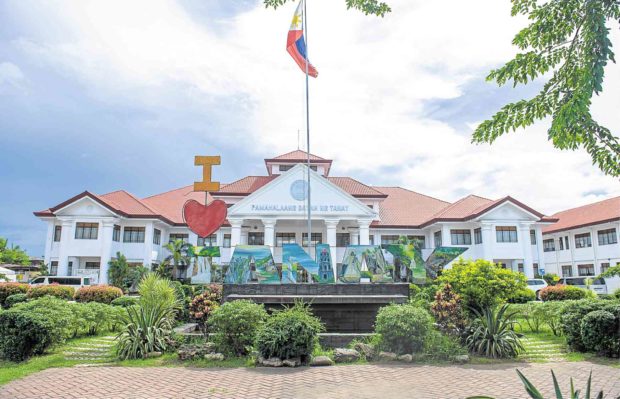
Tanay has been attracting outdoor enthusiasts. —NIKON CELIS
In Angono, an art tour ends perfectly with meal at art galleries and restaurants. Visit the Nemiranda Cafe and Restaurant, owned by artist Nemesio Miranda Jr., and Balaw Balaw Restaurant and Art Gallery, both located on Doña Justa Street.
Balaw-balaw is a term used for “binuro” or fermented dishes. The restaurant is known for serving exotic dishes like the nilasing na palaka, adobong uok, and antik.
“When you say ‘arts capital,’ it is no longer just Angono, but it has become the whole of Rizal,” Laserna said.
From Angono, a short ride to the Taytay tiangge near the public market allows for a quick shopping spree. Stalls sell overruns mostly from Bangladesh and China at more than half the mall price.
Rizal may not have (at least not yet) the modern theme parks, resorts, or high-end shopping malls. But with a beauty this natural and a culture so rich, a weekend getaway is more than enough to keep stomachs full and spirits alive.
Itinerary
Saturday
Take a van from Starmall on Shaw Boulevard in Mandaluyong City (P70/head) to Tanay town center. Jeepneys (P53/head), on the other hand, are available as early as 2 a.m. Travel time is about 1 hour and 45 minutes. From Cubao, Quezon City, there are jeepneys going to Antipolo City but will require another ride to reach Tanay.
7 a.m. – Arrive at Tanay town center. For those taking public transportation, tricycles (P50/head) are available going to Calinawan cave.
7:45 a.m. – Calinawan cave (Sitio Sambal, Barangay Tandang Kutyo)
9:30 a.m. – Daranak falls (open daily from 8 a.m.-5 p.m. Entrance is P50; picnic sheds are available.)
11:30 a.m. – Tanay Lakeshore and Parola
Lunch-Noon – Kainan sa Tabing Lawa (along Lakeshore Drive, open daily from 9 a.m. – 10 p.m.)
2 p.m. – Tanay Church or San Ildefonso de Toledo
3 p.m. – Pililia wind farm (Barangay Halayhayin, Pililia; free entrance)
4:30 p.m. – Regina Rica (Sitio Aguho, Barangay Sampaloc, Tanay; free entrance)
Dinner-6 p.m. – Rambull’s Bakahan (Manila East Road, open 24 hours)
For overnight stay, several hotels and inns are available in the town center and nearby villages. Among them are:
- Bakasyunan (Barangay Balimbing)
- Momarco (Barangay Bathala)
- Sampaloc Inn (Barangay Sampaloc)
- Sierra Madre (Barangay Sampaloc)
- Ten Cents to Heaven (Barangay Cuyambay)
SUNDAY
6 a.m. – Leave for Antipolo City
7 a.m. – Mass at Antipolo Cathedral or the Shrine of Our Lady of Peace and Good Voyage
8 a.m. – Pasalubong center
9 a.m. – Boso-boso Church or Nuestra Señora de la Annunciata Parish (Sitio Boso-boso, Barangay San Jose). Founded by the Jesuits, the church is the oldest in Antipolo City.
8:30 a.m. – Hinulugang Taktak Falls (Entrance fee for adults P30/ students P15/ foreigners P100, use of pool P50)
9:30 a.m. – Pinto Art Museum (1 Sierra Madre St., Grand Heights / open from Tuesday to Sunday, 9 a.m.- 6 p.m. Entrance fee is P200.)
11 a.m. – Angono Petroglyphs (Angono-Binangonan boundary near Thunderbird Resort, free entrance)
Lunch-Noon – Balaw Balaw Restaurant and Art Gallery (Doña Justa St. / Open daily from 10 a.m.-10 p.m.)
1:30 pm – Angkla Art Gallery (corner Col. Guido Street and Manila East Road)
Blanco Family Museum (Doña Nieves Street / Open daily from 8 a.m.-12 noon and 1 p.m.- 6 p.m., entrance fee is P100 for adults and P70 for students)
Carlos “Botong” Francisco house and Carlos “Totong” Francisco II gallery on Mural Street (Doña Aurora St.)
Angono lakeside park
5 p.m. – Nemiranda Cafe and Restaurant (Doña Justa St.)
6 p.m. – Shopping at Taytay tiangge (near Taytay public market)
From Taytay, jeepneys or vans are available going to Ortigas Avenue. Private vehicles may take Ortigas Avenue or Manggahan floodway on way back to Metro Manila.